The global unmanned aerial vehicles (UAVs) simulation market was valued at $0.6 billion in 2021, and is projected to reach $2.5 billion by 2031, growing at a CAGR of 14.6% from 2022 to 2031.
Unmanned aerial vehicle (UAV) is an aerial transportation medium that operates without on-board crew or passengers guided by remote control, autonomously, or both. UAV is the next generation aircraft technology utilized for surveillance, assessment, logistics, and photography. UAV has application in the various industries including military & defense, agricultural, civil & commercial, logistics & transportation, healthcare, construction & mining, and others. For effective working of UAVs in several sectors UAVs simulation is utilized to train operators. It is used to train operators or pilots to control an unmanned aircraft or its payload from a control station. UAV simulation systems play an important role in the training of personnel as these systems artificially recreate aircraft flight environment for pilot training or other purposes.
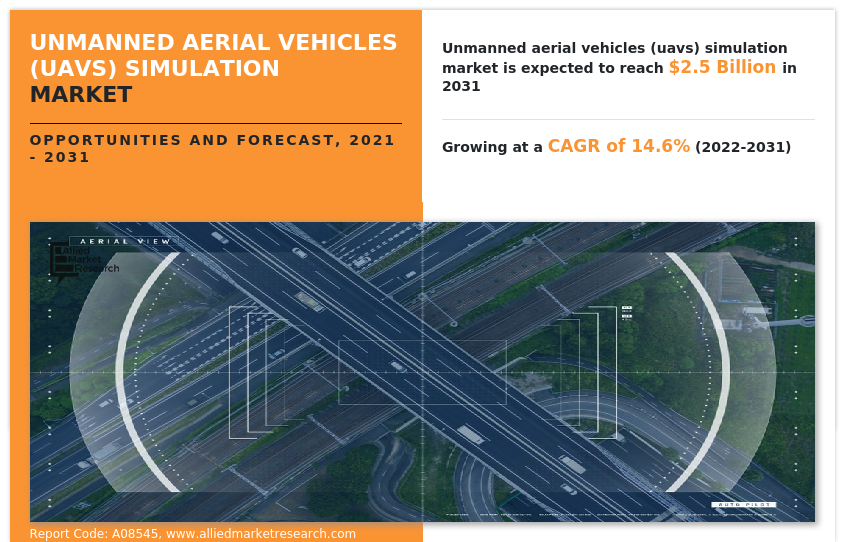
The procurement of UAV simulation systems is costly and requires large capital spending for its integration in a variety of platforms. Conversely, increase in military and defense expenditure globally facilitates the implementation of expensive, yet critical UAV technologies. Furthermore, advancements of weapons and attacking capabilities across the globe have created the demand for modernization and installation of sophisticated defense infrastructure by governments to prevent threats and offensive attacks from foreign countries. Hence, increase in defense expenditure is expected to open new avenues for the growth of the unmanned aerial vehicles simulation market during the forecast period.
The global unmanned aerial vehicles simulation market is experiencing growth, due to rising adoption of UAVs in military and commercial applications, and less number of skilled and trained pilots. However, high cost of UAV simulation systems hampers the growth of the market. Furthermore, rise in defense expenditure globally, and contracts & agreements with military forces are expected to offer growth opportunities during the forecast period.
The unmanned aerial vehicles (UAVs) simulation market is segmented on the basis of component, drone type, end use, and region. By component, it is bifurcated into hardware, and software. By drone type, it is classified into fixed-wing, and rotary wing. By end use, it is categorized into military, and civil & commercial. By region, the report is analyzed across North America, Europe, Asia-Pacific, and LAMEA.
Some leading companies profiled in the UAVs simulation report comprises Bluehalo, CAE Inc., General Atomic Aeronautical System Inc., Havelsan A.S., Indra Sistemas, Israel Aerospace Industries Ltd., Leonardo S.P.A, L3Harris Technologies Inc., Quantum 3D, Raytheon Technologies Corporation, Simlat UAS Simulation, and Singapore Technologies Electronic Limited.
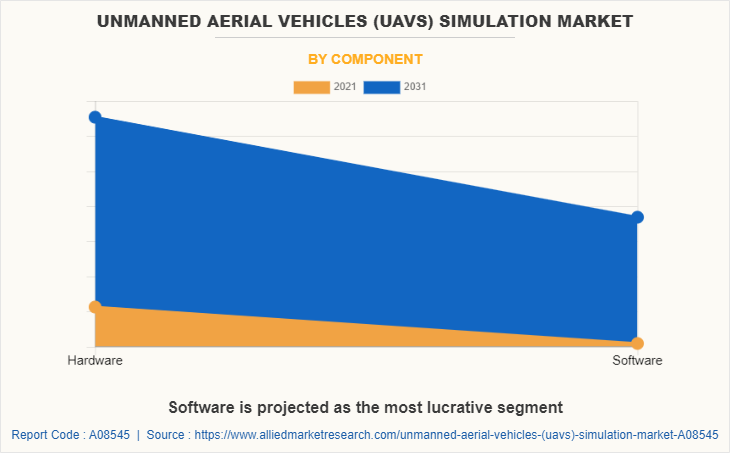
Rising adoption of UAVs in military and commercial applications
UAVs are deployed to work in different places where there is a risk to human life. It is used in various industries including military & defense, agricultural, civil & commercial, logistics & transportation, healthcare, construction & mining, and others. Therefore, there is an increase in the demand for unmanned aerial vehicles simulation systems, to develop a trained and skilled workforce for handling these vehicles.
UAV simulation systems offer a cost-effective solution in training as it replicates the real scenarios using computers and simulation. In civil aviation or military, it is costlier to utilize an actual aircraft to train a pilot and it could harm the human as well. It provides headsets or gloves or other hardware systems that can create a virtual environment similar to real world, where a trainee can understand and tackle challenges with strategic mapping. Rise in adoption of UAVs in military and commercial applications is expected to drive the growth of the UAV simulation market during the forecast period.
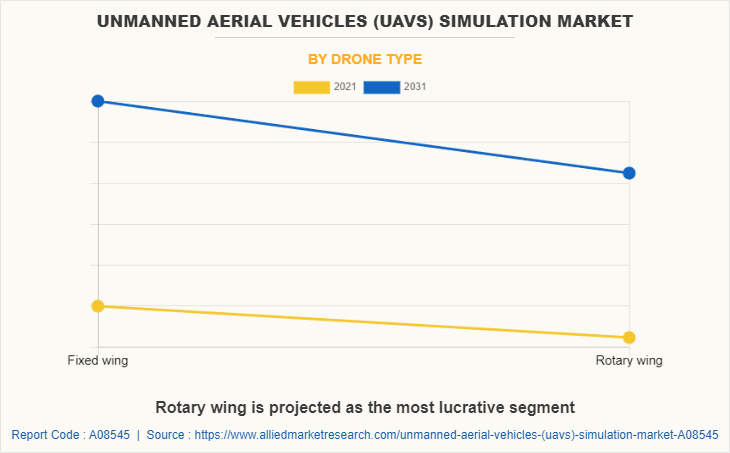
Less number of skilled and trained pilots
Less number of skilled pilots, who can fly these advanced unmanned aerial vehicles such as drones is the major factor that drives the demand for UAV simulation systems which in turn drives the growth of the market. This factor not only prevails in the defense sector, but is also prevalent in the commercial sector. As with any flourishing market, it is usually difficult finding the trained workers to fill UAV-related jobs. Therefore, there is an increase in the need of simulation systems to train people across several industries. In UAV market space, the innovation is rapidly outpacing training, and the lack of qualified personnel can limit growth opportunities for providers as well as suppliers. Moreover, regulations tend to change rapidly to meet the requirements of present and future commercial uses. All these factors are expected to drive the growth of the unmanned aerial vehicles simulation market during the forecast period.
Contracts and agreements with military forces
Military agencies are the key consumers of unmanned aerial vehicle (UAV) solutions & related services. The procurement activities of these unmanned aerial vehicle (UAV) simulation solutions are planned by considering the budget allocations and security severity. The commencement of the unmanned aerial vehicle (UAV) simulation solutions are anticipated to be carried out through long-term agreements and contracts between defense department and solution suppliers of unmanned aerial vehicle (UAV) solutions. These agreements mention a set of requirements that must be met in a certain timeframe as these simulation solutions are made to order products as per end user requirements. These contracts and agreements are associated with long-term business opportunities with these military agencies as well. Thus, unmanned aerial vehicles (UAVs) simulation market participants need to focus on winning the contracts and agreements to gain a competitive advantage in the global market
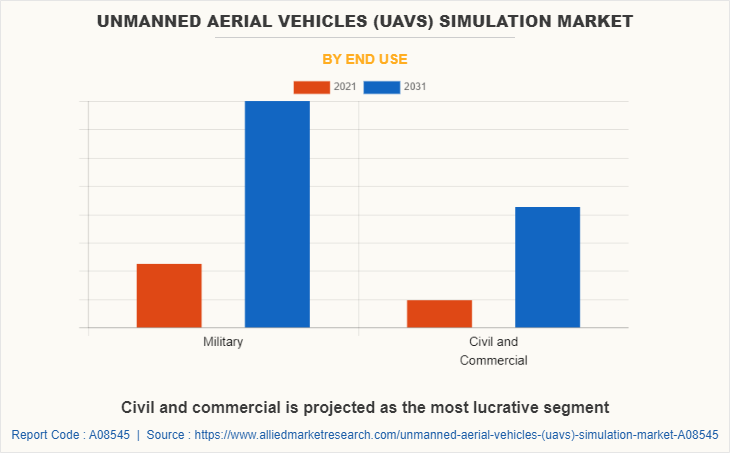
High cost of UAV simulation systems
UAV comprises several components such as sensor payload, avionics, propulsion systems, and other technologies. Simulation systems are integrated with high-quality hardware and software systems, depending upon the applications, deployment and their utilization for armed forces. These factors or parameters increase the final price of UAV simulation systems, thus, hampering the market growth. Moreover, lack of investments in R&D of UAV simulation systems is another factor projected to hamper the market growth. Manufacturers in the UK, Germany, and others are more focused on delivering the product rather than investing in R&D activities. This is projected to restrict the growth of the unmanned aerial vehicles (UAVs) simulation market as novel solutions would not be produced to tackle existing challenges, which are yet to be solved.
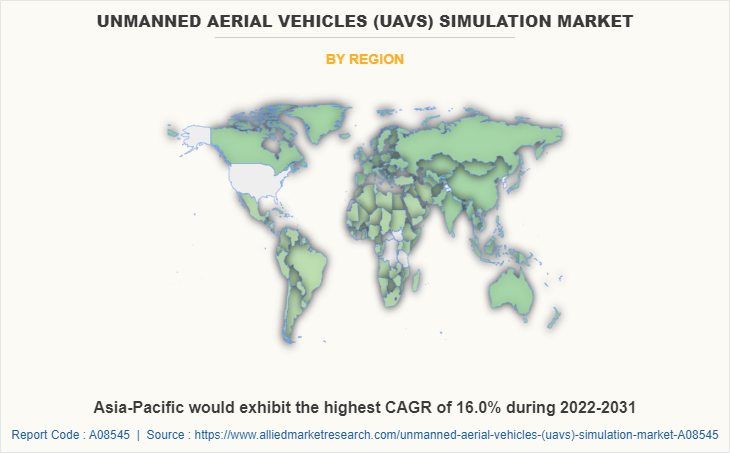
Key Benefits For Stakeholders
- This report provides a quantitative analysis of the market segments, current trends, estimations, and dynamics of the unmanned aerial vehicles (UAVs) simulation market analysis from 2021 to 2031 to identify the prevailing unmanned aerial vehicles (UAVs) simulation market opportunities.
- The market research is offered along with information related to key drivers, restraints, and opportunities.
- Porter's five forces analysis highlights the potency of buyers and suppliers to enable stakeholders make profit-oriented business decisions and strengthen their supplier-buyer network.
- In-depth analysis of the unmanned aerial vehicles (UAVs) simulation market segmentation assists to determine the prevailing market opportunities.
- Major countries in each region are mapped according to their revenue contribution to the global market.
- Market player positioning facilitates benchmarking and provides a clear understanding of the present position of the market players.
- The report includes the analysis of the regional as well as global unmanned aerial vehicles (UAVs) simulation market trends, key players, market segments, application areas, and market growth strategies.
Unmanned Aerial Vehicles (UAVs) Simulation Market Report Highlights
| Aspects | Details |
| Market Size By 2031 | USD 2.5 billion |
| Growth Rate | CAGR of 14.6% |
| Forecast period | 2021 - 2031 |
| Report Pages | 246 |
| By Component |
|
| By Drone Type |
|
| By End Use |
|
| By Region |
|
| Key Market Players | General Atomics Aeronautical Systems, Inc., SINGAPORE TECHNOLOGIES ELECTRONICS LIMITED, Quantum3D, HAVELSAN A.S., Raytheon Technologies, CAE Inc., Israel Aerospace Industries Ltd., Indra Sistema, L3Harris Technologies, Inc., SIMLAT UAS SIMULATION, BLUEHALO, Leonardo S.p.A. |
Analyst Review
The global unmanned aerial vehicles (UAVs) simulation market is expected to witness significant growth due to rising adoption of UAVs in military and commercial applications, and a smaller number of skilled and trained pilots.
The key players of the market focus on introducing technologically advanced products to remain competitive in the market. North America accounted for a major share of the market in 2021, owing to the presence of major players in the region. However, Asia-Pacific is also expected to grow at the highest CAGR, owing to rise in adoption of UAVs in military and commercial applications.
The global military expenditure has seen exponential growth in recent years. According to Stockholm International Peace Research Institute (SIPRI), the global military expenditure has reached $1,981 billion in 2020 with a 2.6% year-on-year increase. The military expenditure accounted for 2.4% of global gross domestic product in 2020. Thus, increase in global military expenditure has augmented the adoption of modern defense systems, including unmanned aerial vehicles (UAV) simulation systems and related technologies.
The global unmanned aerial vehicles (UAVs) simulation market was valued at $0.6 billion in 2021 and is projected to reach $2.5 billion in 2031, registering a CAGR of 14.6%.
The leading companies include Bluehalo, CAE Inc., General Atomic Aeronautical System Inc., Havelsan A.S., Indra Sistemas, Israel Aerospace Industries Ltd., Leonardo S.P.A, L3Harris Technologies Inc., Quantum 3D, Raytheon Technologies Corporation, Simlat UAS Simulation, and Singapore Technologies Electronic Limited.
The largest regional market is North America.
The leading application is military.
The upcoming trends include greater demand from the commercial sector and technological advancements in military-related applications.
Loading Table Of Content...


